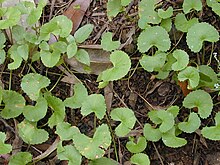Centella asiatica
| Centella asiatica | |
|---|---|
 |
|
| Scientific classification | |
| Kingdom: | Plantae |
| (unranked): | Angiosperms |
| (unranked): | Eudicots |
| (unranked): | Asterids |
| Order: | Apiales |
| Family: | Apiaceae |
| Subfamily: | Mackinlayoideae |
| Genus: | Centella |
| Species: | C. asiatica |
| Binomial name | |
|
Centella asiatica (L.) Urban |
|
| Synonyms | |
Hydrocotyle asiatica L.
Trisanthus cochinchinensis Lour.
Centella asiatica, commonly known as centella, Asiatic pennywort or Indian pennywort, is a herbaceous, frost-tender perennial plant in the flowering plant family Apiaceae, subfamily Mackinlayoideae. It is native to wetlands in Asia. It is used as a culinary vegetable and as medicinal herb.
Centella grows in tropical swampy areas. The stems are slender, creeping stolons, green to reddish-green in color, connecting plants to each other. It has long-stalked, green, rounded apices which have smooth texture with palmately netted veins. The leaves are borne on pericladial petioles, around 2 cm (0.79 in). The rootstock consists of rhizomes, growing vertically down. They are creamish in color and covered with root hairs.
The flowers are white or pinkish to red in color, born in small, rounded bunches (umbels) near the surface of the soil. Each flower is partly enclosed in two green bracts. The hermaphrodite flowers are minute in size, less than 3 mm (0.12 in), with five to six corolla lobes per flower. Each flower bears five stamens and two styles. The fruit are densely reticulate, distinguishing it from species of Hydrocotyle which have smooth, ribbed or warty fruit. The crop matures in three months, and the whole plant, including the roots, is harvested manually.
Centella asiatica is indigenous to the Indian subcontinent, Southeast Asia, and wetland regions of the Southeastern US. Because the plant is aquatic, it is especially sensitive to biological and chemical pollutants in the water, which may be absorbed into the plant. It can be cultivated in drier soils as long as they are watered regularly enough (such as in a home garden arrangement).
In Myanmar cuisine, raw pennywort is used as the main constituent in a salad made also with onions, crushed peanuts, bean powder and seasoned with lime juice and fish sauce.
...
Wikipedia
